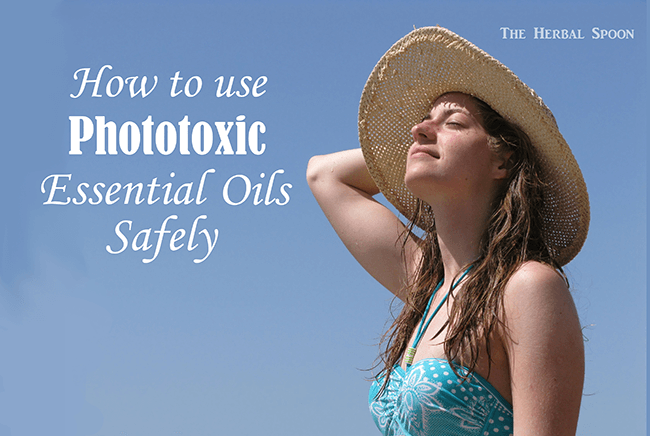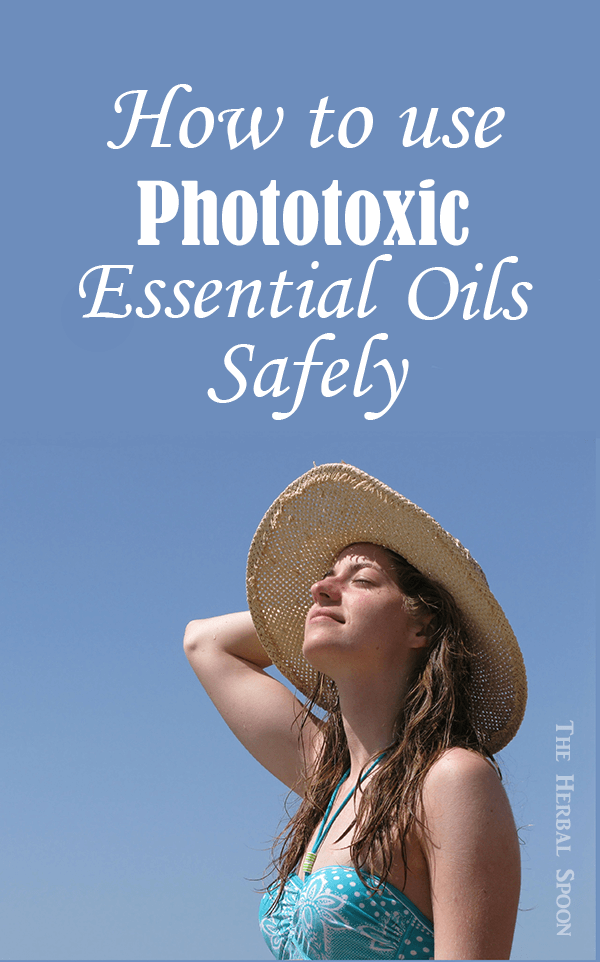There are a lot of essential oil myths floating around out there. I covered quite a few of them in this post here, like if it’s really so scary to ingest oils, or if you can use them safely on little ones. Something I’ve learned more about recently though is what phototoxic essential oils REALLY are and how to safely use them.
I thought I had it figured out. Citrus essential oils were phototoxic, meaning that when they were applied to the skin they could cause skin to be much more likely to burn in the sun. But.. I had it all wrong.
Are Citrus Essential Oils Phototoxic?
Yes and no. Certain essential oils do cause the skin to be more prone to burning and many of them are citrus oils. However, not all citrus essential oils are phototoxic. Here’s a list of phototoxic essential oils according to Robert Tisserand and the International Fragrance Association, or IFRA.
Phototoxic essential oils
- Bitter orange peel, cold pressed
- Fig leaf absolute
- Bergamot oil, cold pressed
- Lime oil, cold pressed
- Lemon oil, cold pressed
- Grapefruit oil, cold pressed
- Cumin oil
- Rue oil
- Angelica root oil
Update: There’s controversy over grapefruit being on this list, as professionals in the essential oil field have said that an analysis of the chemical breakdown of the oil and the existing literature show no concerns of phototoxicity. Being a citrus oil however, it tends to just get lumped in with the avoid list. This info comes from a personal conversation with Jessie Hawkins PhD of the Franklin Institute.
Citrus oils that are NOT phototoxic
- Lime oil, steam distilled
- Lemon oil, steam distilled
- Mandarin, cold pressed
- Tangerine, cold pressed
- Sweet or wild orange (citrus sinensis), cold pressed
Phototoxic Essential Oil Safety for Skin
Based off of my readings from different aromatherapy blogs, I was well aware of the fact that phototoxic essential oils just shouldn’t be used on the skin. Or if you did use them, to make sure you didn’t expose skin to the sun for at least 12 hours, or up to 3 days. That’s not exactly true though.
Wash off products
If you’re including the phototoxic essential oil in a wash off product, then the same rules don’t apply. Since the essential oil won’t be sitting on the skin, there is no concern for phototoxicity. So you can wash your face with a lemon oil laced scrub and go out for a day at the beach with no ill effects.
Anything that’s meant to be washed off of the skin, such as soap, shampoo, face wash and body scrubs can safely use phototoxic essential oils. Each oil however has a maximum percentage that can be used in products before you’re risking skin irritation and sensitization. These guidelines of course are referring to skincare only and don’t apply to essential oils used in higher concentrations for medical purposes.
Leave on products
Some bodycare products that use essential oils are meant to be left on the skin, such as lotion, body butter, body spray and lip balm. Since the oils are going to be sitting on the top layer of the skin somewhat, you do have to exercise more caution here.
Most people believe that phototoxic essential oils can’t be used on the skin at all under any circumstance, but there are actually safe usage limits for leave on products. These guidelines don’t include essential oils used on the lip area. Since the lips are more delicate, the use of essential oils on them is more restricted. In general, essential oils make up about 2% of skincare products. They’re very concentrated substances, so you don’t need much.
Below are the maximum percentages of certain phototoxic oils that can be used on the skin, and roughly how many drops that would be per ounce of carrier oil or other material. The IFRA guidelines differ a little from what Tisserand recommends in his book Essential Oil Safety. Tisserand seems to be a little more conservative with phototoxic essential oil usage.
Using phototoxic essential oils in leave on products (lotion, body butter, body spray)
Lemon, cold pressed – 2% or about 12 drops per ounce of carrier
Lime, cold pressed – .7% or about 4 drops per ounce of carrier
Bergamot, cold pressed – .4% or about 2 drops per ounce of carrier
Grapefruit, cold pressed – 4% or about 24 drops per ounce of carrier
Bitter orange, cold pressed – 1.25% or about 7 drops per ounce of carrier
Using phototoxic essential oils in wash off products (soap, face wash, body wash)
Lemon, cold pressed – 5% or about 30 drops per ounce of carrier
Lime, cold pressed – 25% or about 150 drops per ounce of carrier
Bergamot, cold pressed – 5% or about 30 drops per ounce of carrier
Grapefruit, cold pressed – 5% or about 30 drops per ounce of carrier
Bitter orange, cold pressed – Listed as no restriction for wash off product. I can’t locate a maximum usage limit for bitter orange, although I’m assuming an undiluted oil could be irritating to skin. Based off of other usage guidelines, I personally wouldn’t use more than 5% in a wash off product, or about 30 drops per carrier.
Resources:


Hi Jamie,
This is a very interesting article and informative. I found it very educational for myself because I was not sure of which citrus oils were safe in the sun and which weren’t. Thanks for sharing your information. Thanks for sharing on Real Food Fridays. Pinned & tweeted. Have a healthy happy blessed Thanksgiving.
I love essential oils! This was very informative. Thanks for sharing this with us at Savoring Saturdays linky party. Hope you’ll come back and join us again.
Hi Jamie,
Thank you so much for such an informative post.This article was extremely useful. I like your clear and well organized writing
Thanks Rivana 🙂
I read your blog with great pleasure, as the oils are really a powerful tool, for sinusitis, otitis, dermatitis and a lot of ailments ! Just my stomac refuse mint and anise as too strong also 1 drop diluted in water and honey, tried and learnt not to repeat !
Yes, they are very potent, especially if not properly diluted! It’s good that you’ve found what works (and doesn’t) for your body, as we’re each different in so many ways. Did you happen to stir the essential oil into at least 1 tsp of honey thoroughly before adding it to the water, or did you just stir them both into the water at the same time? Not stirring it into the honey first might have made a difference too 🙂
hey, i want to mix lemon oil into a blend i wish to sue for moisturizing and skin brightening. the cold pressed lemon oil is recommended at a max of 2% dilution, but i want to use the steam distilled variant and was wondering what the recommended dilution would need to be to achieve the effect i want (a shade or 2 lighter skin tone). I’ve read people recommending anywhere from 15-20% for steam distilled lemon oil, but cant find any IFRA guidelines pertaining to that specific extraction method. So i come asking you in the hopes that you will have information that i cannot find.
Hi Godwin, I took a look at my Essential Oil Safety book by Tisserand and they give specific topical application guidelines for the steam distilled lemon oil. I don’t agree with Tisserand on everything, but he’s an excellent resource for skincare and follows IFRA pretty closely. That book recommends using up to 20%, but I doubt you’d need that much, and probably 2-5% would be suitable for skincare. I’m not sure how well it will work as a bleaching product, but I’ve seen it do really well at removing freckles and dark spots on the skin. He does mention that the distilled oil is used more for flavoring foods instead of skincare. Thanks for you comment!
I am curious to know what happened to my skin, as I had spilled some bergamot oil on my hand, and noticed some freckles there a few days later. I understand that my skin has been exposed to uv light and therefore the ‘freckles’ have appeared. But what damage/harm has been done? Surely the spots will fade, they don’t hurt, and I have not been burned by the sun. Do you have any insight on the after effect of sun exposure when these oils have been on a top layer of skin?
That sounds like an interesting issue. I’d be interested to know if the spots have faded, as I’m really not sure what’s going on here. If you’re really concerned a dermatologist or a certified aromatherapist will be able to offer more insight. I’m guessing the aromatherapist will know more about it than the dermatologist though since they don’t receive any training in essential oils. Let me know how it turns out!
Thank you so much for this article. It’s exactly what I was looking for. So appreciated.
I’m glad it’s been helpful!